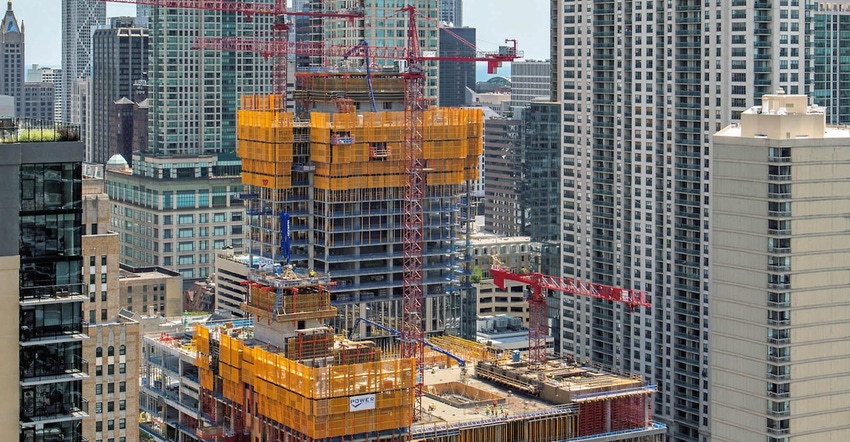One Chicago is an award-winning project that includes grade-100 reinforcement. In this Q&A, the developer talks about why his firm increased the reinforcing strength to reduce the quantity of rebar, which lessened labor costs and the concrete pour time.

The One Chicago development in Chicago’s River North neighborhood stands out among the city’s iconic skyline. This year the project was selected as a recipient of CRSI’s Honors Award for the residential and hotel category for displaying design and construction excellence after utilizing top-down construction and grade 100 reinforcement, according to a statement from CRSI.
The development features two towers, a 78-story tower and a 50-story tower and stands as the sixth-tallest building in Chicago. We spoke to Doug Metzer, an executive vice president at JDL Development, the company that developed One Chicago, to find out about the use of grade 100 reinforcement and the impact top-down construction had on the project.
Q.) The One Chicago project is so impressive in scale;, how long did the pre-construction phase last?
A.) We began planning the project in early 2017 and construction began in March 2019. We went through many iterations of massing and planning before settling on the scheme we built.
Q.) Tell us about the use of grade 100 in the steel-reinforced concrete foundation. Why was grade 100 reinforcement chosen?
A.) Grade 100 rebar was originally suggested by McHugh Concrete as a value engineering opportunity. The foundations for a building of this scale are massive by nature given the magnitude of the varying forces we have to counteract. Increasing reinforcing strength actually made the mat foundation and grade beams more workable by reducing the quantity of individual pieces of rebar. This, in turn, helped with labor cost and placement of the concrete itself at time of pour. The team began planning for the use of grade 100 reinforcement in April 2019 anticipating the update to ACI 318-19 in June to allow the use of grade 100 reinforcement in these conditions. The update was indeed approved and published in June 2019, about four months before we were set to place the affected foundation elements.
Q.) Talk about the use of top-down construction and how this resulted in an accelerated construction schedule and enhanced constructability.
A.) The use of top-down construction indeed resulted in schedule enhancement. The first activity on site was drilling caisson foundations and interlocking secant piles for the earth retention system. Next, the team cut the grade down to the elevation of the first basement. A mud mat slab was poured to act as a bottom form for the lower level 1 (LL1) slab. While the slab was prepared to be poured in phases, sheet piling was driven at the tower cores to allow excavation to the mat foundations and construction of the core walls to grade. During this time, the team also erected three tower cranes to support the concrete construction efforts. After the LL1 slab was placed, the concrete crews began decking up to the level 1 (L01) slab and work began on digging down to the lower level 2 (LL2) elevation. This continued until we reached the last basement level, lower level 4.
Q.) Did the use of top-down construction yield cost savings for the project? If so, were the savings significant?
A.) As compared directly to a traditional bottom-up construction method, top-down construction is more expensive at face value. Excavation is slower as it is a true mining operation, and you pay to place and remove mud mat slabs in lieu of erecting formwork overhead and stripping post-pour. However, the time saved by being able to concurrently work vertically resulted in an overall savings to the project between a reduced construction schedule (reduced contractor GCs), reduced interest expense and construction loan duration, and earlier building occupancy and collection of revenue. This is truly a project-by-project analysis and determination; there is a time and place for top-down construction and when it is appropriate, it is a game changer.
About the Author(s)
You May Also Like




